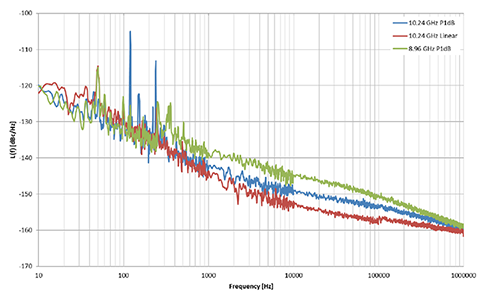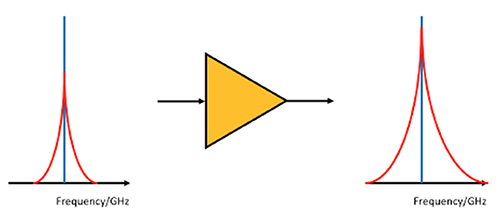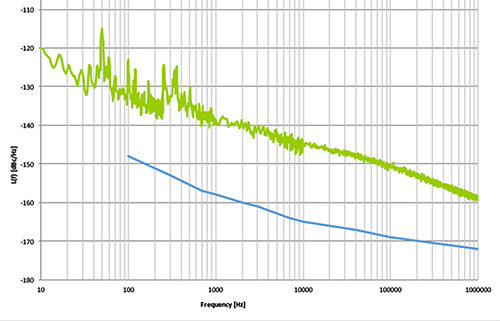Addressing Phase Noise Challenges in Radar and Communication Systems: Part 2
July 18, 2019
This blog post was first published by Custom MMIC who joined the Qorvo family in February 2020. Custom MMIC is known for its best-in-class die and packaged components, which augment our power amplifiers to enable multi-chip modules for a broad range of defense, aerospace and commercial applications.
Introduction
 In part 1 of this blog series, we discussed phase noise and how it can affect the performance of direct down conversion receivers and radar systems. In part 2, we'll discuss what can be done to lessen the effects of phase noise in your microwave systems using Custom MMIC's solutions.
In part 1 of this blog series, we discussed phase noise and how it can affect the performance of direct down conversion receivers and radar systems. In part 2, we'll discuss what can be done to lessen the effects of phase noise in your microwave systems using Custom MMIC's solutions.
Amplifiers and Phase Noise
One obvious place to limit phase noise is in the choice of oscillator. This problem can be addressed by spending considerable time and money to design or procure a low-noise oscillator. However, most oscillators do not generate enough output power, and indeed let us assume that for a particular application, the oscillator output of +5 dBm needs to be amplified to a level of +15 to +17 dBm in order to drive the LO port of a mixer. The question then becomes - Does the amplifier affect the phase noise of the LO signal?
In an ideal situation the answer would be “no”, as the amplifier would simply raise desired LO signal and the skirts by the same level. However, in reality, microwave amplifiers add noise of their own to any signal, and herein lies the problem. All electronic devices exhibit a phenomenon called 1/f noise or “pink noise”, which is noise power that is added to an input signal spectrum but falls off proportionally to the inverse of the offset frequency. In Figure 4, we present the phase noise of the CMD307P3, a low-noise amplifier covering the 10 to 17 GHz range, versus offset frequency away from the desired signal. The phase noise of the incoming signal has been canceled out, so this plot represents the noise generated by the amplifier.
 Figure 4: CMD307P3 LNA Phase Noise
Figure 4: CMD307P3 LNA Phase Noise
In Figure 4, we note the phase noise falls off linearly on the logarithmic scale with increasing frequency offset, which is characteristic of 1/f noise. If this noise level is higher than the phase noise of the input signal, the amplifier noise would dominate the output noise spectrum. In our example, this means the low phase noise of the oscillator would be replaced by the higher phase noise of the amplifier, thereby defeating the purpose of the low-phase-noise oscillator. A pictorial representation of this phenomenon is shown in Figure 5.
 Figure 5: Degradation of phase noise due to an amplifier.The skirts of the input signal on the left are increased after passing through the amplifier, with the output spectrum on the right.
Figure 5: Degradation of phase noise due to an amplifier.The skirts of the input signal on the left are increased after passing through the amplifier, with the output spectrum on the right.
One obvious question is - Can anything be done to lower the phase noise of amplifiers? The answer lies in device physics. The 1/f noise is caused by random and thermal charge movement in the channel of an active device. The CMD307P3 for example, is manufactured on a Gallium Arsenide (GaAs) pHEMT process with a gate length of 0.13 um. The FET devices on this process typically have a high 1/f corner due to their high electron mobility. GaAs bipolar devices on the other hand, tend to have lower electron mobilities, which means a much lower 1/f noise. So they are considerably better for phase noise than their FET counter-parts. Therefore, one solution to lowering the additive phase noise is to use a GaAs HBT process.
At Custom MMIC we have used our extensive knowledge of amplifier design techniques to create a family of new Low Phase Noise Amplifiers (LPNAs) on a GaAs HBT process operating from 6 to 40 GHz.
In Figure 6, we present the phase noise versus offset frequency for the CMD245 amplifier as housed in a 4 mm QFN-style package, relative to the CMD307P3 HEMT LNA shown previously. We note the phase noise of the CMD245C4 is 15 to 20 dB lower than the CMD307P3 pHEMT LNA.
 Figure 6: Phase noise of the CMD245C4 (Blue) low phase noise amplifier vs. CMD307P3 (Green) LNA.
Figure 6: Phase noise of the CMD245C4 (Blue) low phase noise amplifier vs. CMD307P3 (Green) LNA.
Other components besides oscillators and amplifiers can contribute to phase noise, including frequency multipliers. Many microwave systems utilize a lower-frequency oscillator that is then multiplied to produce a higher frequency. One common approach for multiplication is to use a harmonically-terminated amplifier to generate the required output frequency. Unfortunately, such an approach will then add the amplifier’s phase noise to the multiplied signal, which will degrade the phase noise of the original oscillator.
A second approach is to use passive multiplication, which has the potential to add minimal additional phase noise to the multiplier's signal (aka doublers). Custom MMIC has also created a family of passive HBT-style frequency multipliers which do not add to the phase noise of the input signal. In the table below, we present a summary of Custom MMIC’s passive multiplier die family (SMT packaged versions are also available).
| Product | Output Frequency (GHz) |
|---|---|
| CMD225 | 8 - 16 |
| CMD226 | 14 - 22 |
| CMD227 | 16 - 30 |
Conclusion
In this two-part blog series, we discussed how phase noise is a secondary effect directly related to the topology and construction of the oscillator. We've broken down how phase noise can affect the performance of direct down conversion receivers and radars. Finally, we've presented specific Custom MMIC solutions to solve these challenges.
To review additional data, and to view the complete findings together, download our tech brief: How to Troubleshoot and Fix Phase Noise in Radar and Communications Systems.
Have another topic that you would like Qorvo experts to cover? Email your suggestions to the Qorvo Blog team and it could be featured in an upcoming post. Please include your contact information in the body of the email.